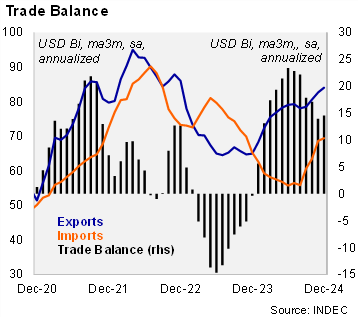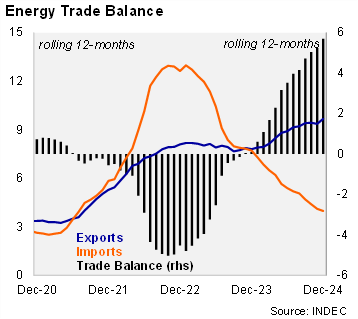The trade balance reached a surplus of USD 18.9 billion in 2024, up from a deficit of USD 6.9 billion in 2023 due to the recovery of agricultural exports after a severe drought and lower imports. On a monthly basis, the trade surplus reached USD 1.7 billion in December, above the USD 1.0 billion surplus registered in the same month of 2023. The surplus was also above market expectations according to the central bank's survey, with analysts estimating a surplus of USD 1.1 billion. At the margin, the seasonally-adjusted annualized trade balance rose to a surplus of USD 14.6 billion in December, from a surplus of USD 14.0 billion in the previous month.

Exports increased in 4Q24, still driven by the normalization of the agricultural sector. Total exports rose by 31.7% yoy in 4Q24, following an 18.2% gain in 3Q24. Agricultural exports, including manufactured agricultural products, expanded by 42.8% yoy in the period (from 20.6% yoy in 3Q24). Exports of other industrial products rose by 21.3% yoy in the same period, led by cars and metals (up from an increase of 11.0% yoy in 3Q24). On a sequential basis, exports rose by 26.6% qoq/saar in December.
Imports expanded in 4Q24, after falling in the last eight quarters. Total imports rose by 7.5% yoy in 4Q24 (from a drop of 17.9% yoy in 3Q24). Imports rebounded by 68.6% qoq/saar in the period. Imports of capital goods increased by 16.2% yoy in 4Q24, while imports of consumer goods (including cars) rose by 48.5% yoy, both in line with the recovery of activity. On the other hand, imports of intermediate goods fell by 2.7% yoy in the period, but from a drop of 19.6% yoy in 3Q24.

The energy trade surplus widened further in December. The rolling 12-month balance reached USD 5.7 billion in December, from a surplus of USD 5.2 billion in the previous month and only USD 0.1 billion in 2023. Energy imports plummeted by 58.4% yoy in 4Q24, while oil exports rose by 11.9% yoy in the same period.

Our take. For 2025 we expect a surplus of USD 12.0 billion driven by lower commodity prices and higher imports consistent with a recovery in economic activity. Of note, the lack of rain at a critical time for the harvest poses risks of a possible drought.
